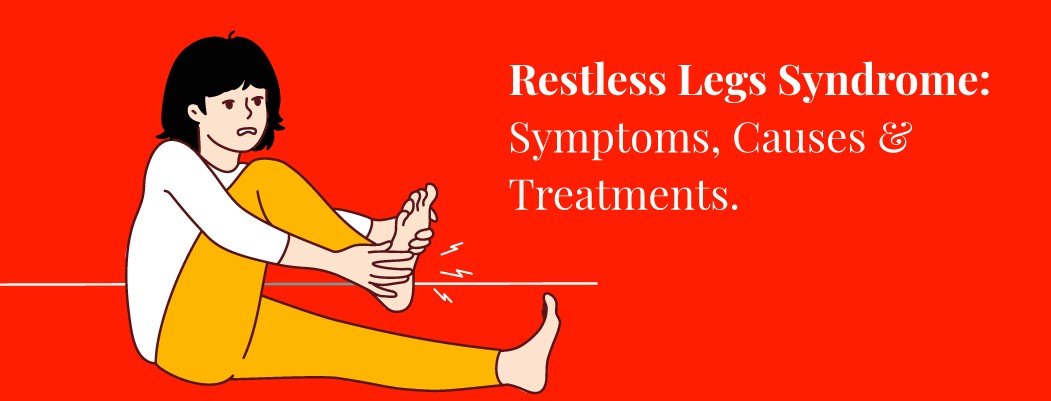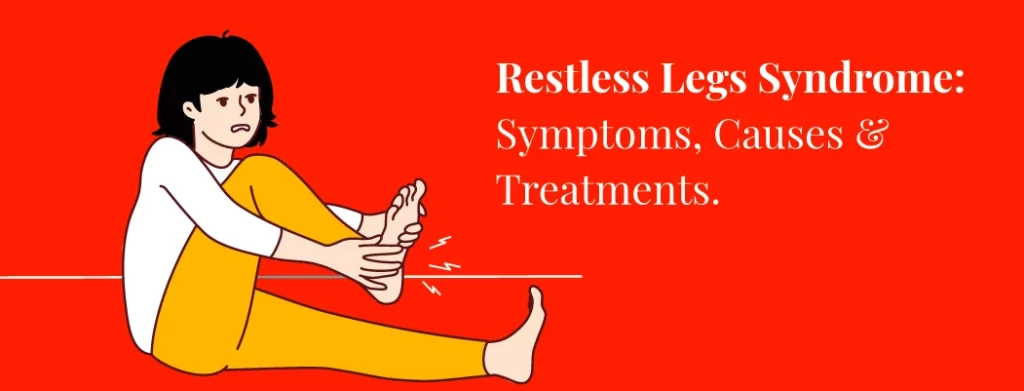
What is restless legs syndrome?
Restless legs syndrome (RLS), or Willis-Ekbom disease, is a sleep disorder that causes a strong and often overwhelming urge to move the legs (and even the arms or body). Other extremity sensations include pulling, crawling, tugging, throbbing, itching, pain, burning, or crawling.
These sensations usually occur while lying in bed or sitting for a long time, such as while driving or watching a movie. RLS usually appears at night, making it difficult to fall asleep. People with RLS often want to walk and shake their arms (or legs) to help relieve uncomfortable sensations.
Who is susceptible to restless legs syndrome (RLS)?
RLS can affect anyone, even young children. RLS symptoms can begin in childhood or adulthood, but as people age, their chances of developing the syndrome increase considerably. Additionally, women are more likely than men to suffer from RLS.
Symptoms of restless legs syndrome
Symptoms of restless legs syndrome include strange sensations in the legs, such as tingling, pins and needles, pulling, pain, pins and needles, and a strong desire to move the legs to relieve symptoms. The disease can also affect other parts of the body, such as the head, chest, or arms. Both sides of the body experience the sensations more frequently. They may occur exclusively on one side or start on one side before moving to the other.
The severity of RLS symptoms varies. The severity may change between episodes and they may come and go. They are generally worse at night and in the late afternoon.
People with RLS can often sleep well early in the morning, as the symptoms almost always disappear.
RLS symptoms can range in severity, from barely noticeable to unbearable. Both the frequency and severity of symptoms can change. Typically, afternoons and evenings are when symptoms are worst. Some people may experience symptoms that severely disrupt their sleep every night, impairing their quality of life.
Causes of restless legs syndrome
Most cases of restless legs syndrome are unknown to medical professionals, although your genes may be involved. A family member with RLS affects approximately half of those who suffer from it.
It could also be connected to the following:
Chronic diseases: RLS symptoms can be a symptom of several chronic medical diseases, such as iron deficiency, Parkinson’s disease, kidney disease, diabetes, and peripheral neuropathy.
Pregnancy: RLS can occur in certain pregnant women, especially in the last trimester. After childbirth, symptoms usually disappear within a month.
Lifestyle: A sleep condition such as apnea or lack of sleep can cause or exacerbate symptoms. Like coffee consumption, smoking and alcohol.
Risk factors for restless legs syndrome
Some factors can make you more susceptible to RLS. However, it is first necessary to clarify which of these elements contributes to SPI.
Among them are:
Gender: RLS affects women twice as often as men.
Age: RLS can affect anyone at any time. However, it tends to appear more frequently and more severely after middle age.
Family history: If other family members have RLS, you are more likely to have it too.
How is restless legs syndrome (RLS) diagnosed?
There is no specific test available for restless legs syndrome (RLS). Its symptoms serve as the basis for the diagnosis. A medical history, complete physical and neurological examination, and blood tests may be performed to rule out any possible health problems related to RLS. Additionally, an overnight sleep study may be recommended to detect other sleep problems, particularly obstructive sleep apnea.
Your doctor will look at any family history of RLS. You will also be asked if you have any sleeping problems, such as insomnia caused by your symptoms. Your doctor will also ask you about any other behavior or performance problems and if you have trouble staying awake during the day.
The following five requirements must be met to confirm a diagnosis of RLS:
Possessing a need or desire to move the legs (or arms), usually accompanied by unpleasant sensations such as pulling, crawling, itching, pain or burning. Also, compulsion to move or feelings of restlessness.
begin or worsen during periods of inactivity or rest.
performing exercises on the affected muscles, such as stretching, walking, or a combination.
They are worse or only occur at night or in the evening.
They are not caused exclusively by another health or behavioral problem.
Treatment Options for Restless Legs Syndrome (RLS)
The severity of the symptoms determines the best treatment for restless legs syndrome. If excessive daytime sleepiness and insomnia affect your quality of life, you should consider treatment. Specific treatment is also required in RLS situations caused by long-term medical conditions.
Remedies without drugs.
First, non-medicinal treatments are explored, especially in cases of mild symptoms. Non-drug treatments include:
Get regular exercise, such as walking or cycling, but avoid strenuous or intense activities just before the evening.
Follow healthy sleep habits, such as sleeping 7 to 9 hours each night and refraining from watching television, reading, or using a computer or phone while lying in bed. RLS symptoms can intensify if you don’t get enough sleep.
You can temporarily relieve pain in your legs by massaging them, using a heating pad, or applying a cold compress. Acupressure, walking, gentle stretching, massage, and other relaxing methods should also be considered.
Take a warm bath
Try to relax as much as you can. For example, try yoga, meditation, soft music, or one of the other options.

